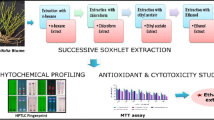Abstract
A flavonoid, Hesperidin was evaluated for its ability to inhibit tumour initiation by a polycyclic aromatic hydrocarbon and tumour promotion by a phorbol ester in the skin of CD-1 mice. Subcutaneous application of Hes-peridin did not inhibit 7,12-dimethylbenz(a)anthracene-induced tumour initiation but did inhibit 12-O-tetradecanoyl-13-phorbol acetate-induced tumour promotion. Results provide evidence for a potential chemopreventive activity of Hesperidin.
Similar content being viewed by others
Abbreviations
- DMBA:
-
7,12-dimethylbenz[a]anthracene
- TPA:
-
12-O-tetra-decanoyl-13-phorbol acetate
- FOR:
-
free oxygen radicals
References
Singleton VL (1981) Naturally occurring food toxicants:phenolic substances of plant origin common in risk foods. Adv Food Res 27:149–242
Nakadate T, Yamamoto S, Aizu E, Kato R (1984) Effect of flavonoids and antioxidants on 12-0-tetradecanoylphorbol-13-acetate caused epidermal ornithin decarboxylase induction and tumor promotion in relation to lypoxygenase inhibition by these compounds. Gann 75:214–222
Kato R, Nakadate T, Yamamoto S, Sugimura T (1985) Inhibition of 12-0 tetradecanoyl-phorbol-13-acetate induced tumor promotion and ornithine decarboxylase activity by quercetin: possible involvement of lipoxygenase inhibition Carcinogenesis 4:1301–1305
Bresnick E, Birt D (1988) Inhibitory effects of the flavonoid, apigenin, on epidermal ornithine decarboxylase and mouse skin tumorigenesis. Proc Am Assoc Cancer Res 29:136
Lasker JM, Huang MT, Conney AH (1984) In vitro and in vivo activation of oxidative drug metabolism by flavonoids. J Pharm Exp Ther 229:162–170
Huang MT, Wood AW, Newmark HL, Sayer J, Yagi H, Jerina DM, Conney AH (1983) Inhibition of the mutagenicity of by-region diol-epoxides of polycyclic aromatic hydrocarbon by phenolic plantflavonoids. Carcinogenesis 4:1631–1637
Verma AK, Johnson JA, Gould MN, Tanner MA (1988) Inhibition of 7,12-dimethylbenz(a)anhracene and N-nitrosomethylureo-flavand quercetin. Cancer Res 48:5754–5758
Rengün A, Baykut F, Kayahan R, Berkarda B, Öz F et al (1981) Preliminary report on the effect of grapefruit (citruis paradise) extract on erlich ascites cells (EAT). Chim Acta Turc 9:25
Baykut F, Benliolu G, Baykut G (1986) Photocatalytic production of ascorbic acid. A secondary photosynthesis in plants. In: Pelizzetti E, Serpone ND (eds) Homogenous and heterogeneous photocatalysis. Reidel Publishing, New York, pp 161–173
Brown JP (1980) A review of the genetic effects of naturally occurring flavonoids anthraquinones and related compounds. Mutation Res 75:243–277
Torel J, Cillard J, Cillard P (1986) Antioxydant activity of flavonoids and reactivity with peroxy radical. Photochemistry 25(2):383–385
Husain SR, Cillard J, Cillard P (1987) Hydroxyl radical scavenging activity of flavonoids. Photochemistry 26(9):2489–2491
Canada AT, Giannella E, Nguyen TD, Mason RP (1990) The production of reactive oxygen species by dietary flavonols. Free Radic Biol Med 9:441–449
Busse WW, Kopp DE, Middleton E (1984) Flavonoid modulation of human neutrophil function. J Allergy Clin Immunol 73:810
Lonchampt M et al (1989) Protective effect of a purified flavonoid fraction against re-active oxygen radicals. Arzneimittelforschung/Drug Research 39(11–8):882–885
Botwell RK (1974) The function and mechanism of promoters of carcinogenesis. CRC Crit Rev Toxicol 2:419–443
Wertz ED (1986) Mn:Relationship between cellular Superoxide dismutase and susceptibility to chemically induced cancer in the rat mammary gland. Carcinogenesis 70: 1197–1201
Cerutti PA (1985) Prooxidant states and tumor promotion. Science 227:375–385
Nygard OF, Simic MG (1983) Radio protectors and anticarcinogens. Academic Press, New York, p 471
Dionisi D, Galeotti T, Terranove T, Azzi A (1975) Superoxide radicals and hydrogen peroxide formation in mitochondria from normal and neoplastic tissues. Biochem Biophys Acta 402:292–300
Kılıç K (1986) Oxygen radicals and superoxide dismutase in cancer. Biokimya 11(3):59–76
Perchellet JP, Perchellet EM (1989) Antioxidants and multistage carcinogenesis in mouse skin. Free Radic Biol Med 7:377–408
Kensler TW, Taffe B (1986) Free radicals in tumor promotion. Adv Free Radic Biol Med 2:347–387
Middleton E, Kandaswami C (1992) Effects of flavonoids on immune and inflammatory cell functions. Biochem Pharmacol 43(6):1167–1179
Baykut F, Baykut D, Baykut G (1989) Failure of the electron transfer mechanism in cancer development, Int J Exp Clin Chemother 2:76–86
Baykut S, Atun G (1987) Investigation of redox characters of some organic substances by using electrochemical and photochromotographic methods. Chim Acta Turc 15:180–201
Author information
Authors and Affiliations
Corresponding author
Rights and permissions
About this article
Cite this article
Berkarda, B., Koyuncu, H., Soybir, G. et al. Inhibitory effect of Hesperidin on tumour initiation and promotion in mouse skin. Res. Exp. Med. 198, 93–99 (1998). https://doi.org/10.1007/s004330050093
Received:
Accepted:
Published:
Issue Date:
DOI: https://doi.org/10.1007/s004330050093



